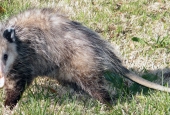Opossums are quite common in Alameda County. They are the only native North American marsupial (animals that carry their young in an abdominal pouch). Although opossums are not native to California (they were introduced from the East coast in 1910), they have become established in most urban and suburban areas.
The adult opossum is about the size of a house cat with coarse grayish fur, a pointed face, and rat-like tail. They may reach 15 pounds and males are typically larger than the females. Their hand-like feet make them excellent climbers, especially with the hairless tail.
Opossum are nocturnal, foraging at night. They are omnivorous, feeding on almost anything. They will eat the fruit right off a tree or on the ground, garden plants and insects, bird eggs, or dead animals in the street
s. In an urban/suburban environment they will eat pet food.
In rural areas, opossums build their nests in wooded areas, often near streams. They will use a hollow log, animal burrows, or dense cover. In an urban environment they will build their nests under a deck, porch, or within a crawl space. They will also nest in sheds, attics, garages, or other undisturbed buildings.
Opossums are tenacious and easily adapt to changing environmental conditions. When opossums become established in a neighborhood they usually remain until the food, water, or shelter is removed.
Female opossums carry their young in in a pouch for two months, after which they emerge and explore the surrounding nesting area. The young experience high mortality. Females can produce two liters a year and adult opossums live for approximately three years.
Opossums can carry a number of infectious diseases including, leptospirosis, tuberculosis, relapsing fever, tularemia, spotted fever, toxoplasmosis, coccidiosis, and Chagas disease.
Two variants of the rabies virus (bat and skunk) are found in California but all mammals are susceptible to rabies infection. The incubation period is highly variable, and typically lasts 3-8 weeks. Rabies infection is nearly always fatal. Infected animals contain large quantities of virus in their saliva, and transmission usually occurs through their bite. Rabies was detected from an opossum in Alameda County in 1999.
Opossums may also be infested with a variety of fleas, ticks, mites, and lice. It is not uncommon for the ectoparasites of opossums to be transmitted to cats and dogs in residential backyard settings.
If the resident is experiencing problems with opossums, it is strongly recommended that they call the district so that a Vector Control Biologist can investigate the nuisance wildlife issue. The Vector Control Biologist will determine the prevention and exclusion methods that would be most successful in removing the opossums from the property.





